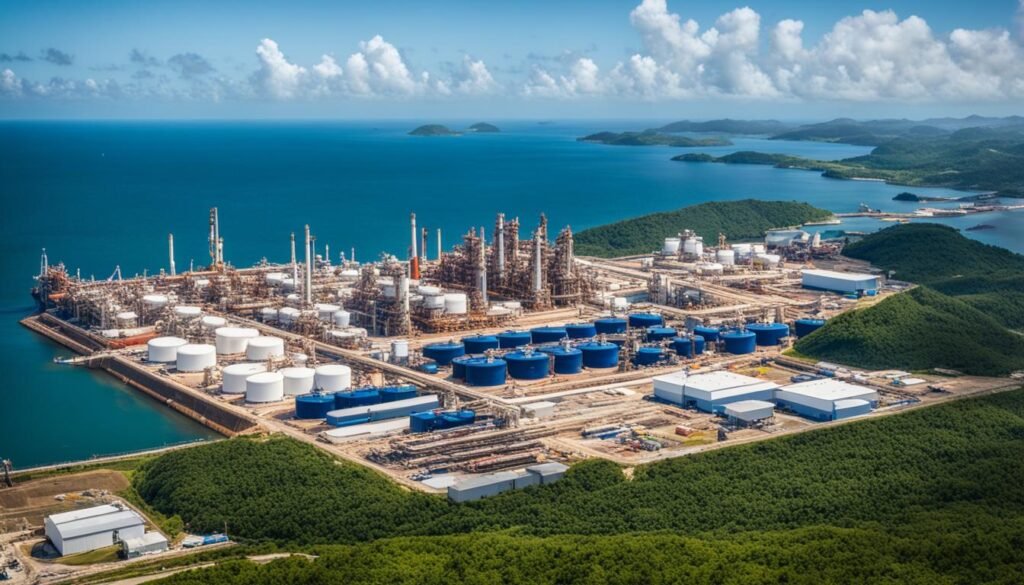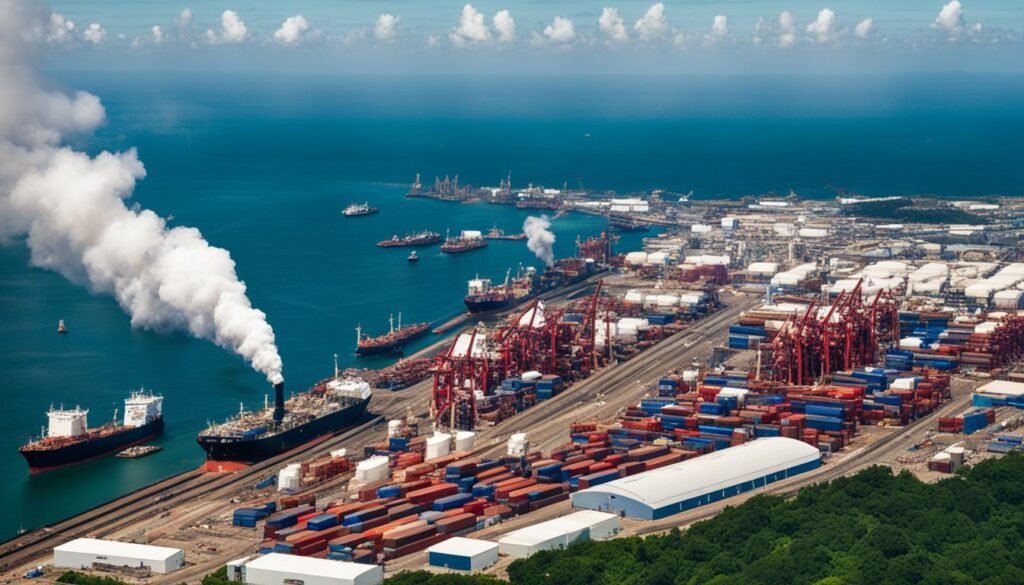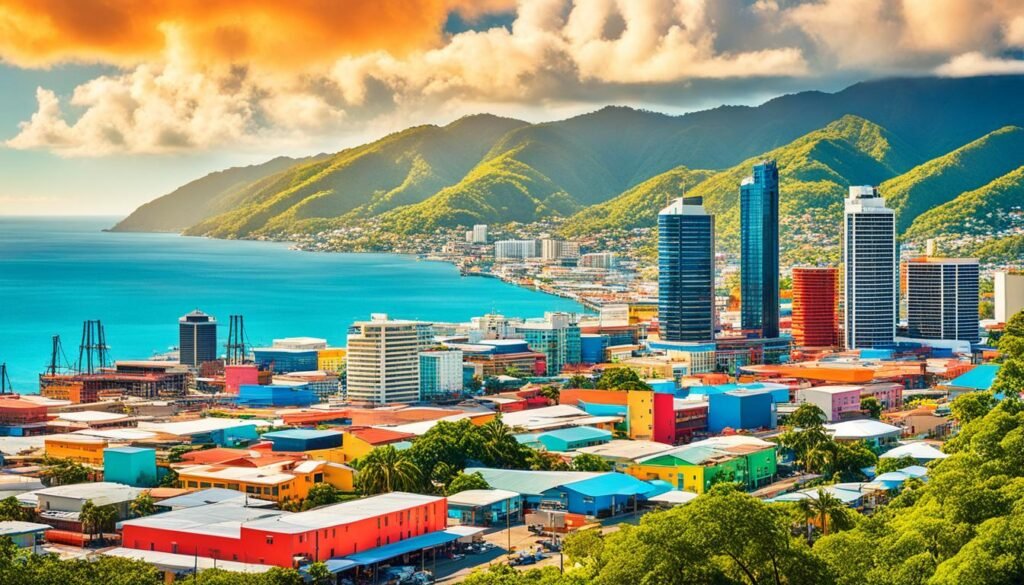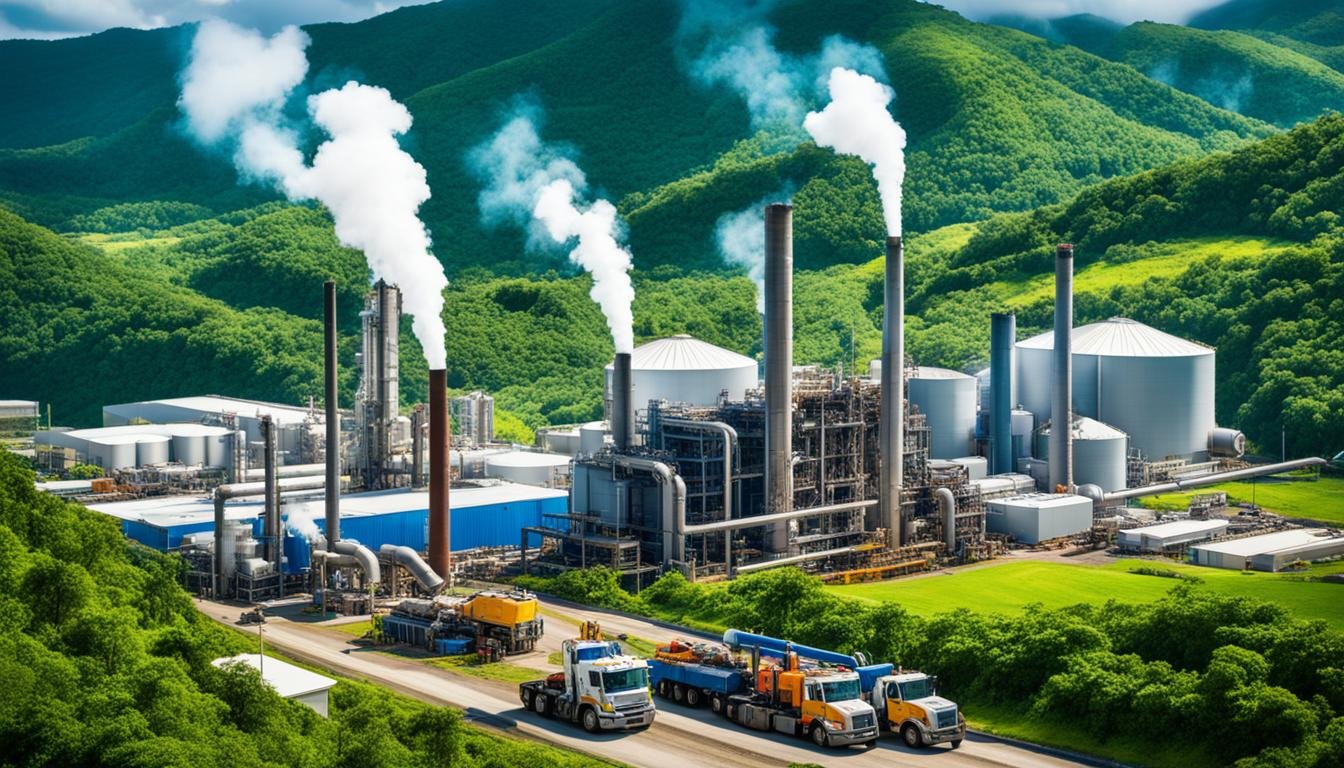Did you know that Trinidad and Tobago, a small twin-island nation in the Caribbean, punches well above its weight when it comes to energy production? This dynamic country accounts for over 80% of the Caribbean’s total oil and natural gas output, making it a powerhouse in the region’s energy landscape.
As the southernmost country in the Caribbean, Trinidad and Tobago’s economy is heavily reliant on the hydrocarbon industry, with the petroleum and petrochemicals sectors contributing an astounding 37% to its Gross Domestic Product (GDP). The nation’s vast reserves of oil and natural gas have transformed it into a major exporter of these commodities, with ores and mineral fuels comprising over 70% of its total exports.
Beyond its role as a leading energy producer, Trinidad and Tobago has also emerged as a significant financial center within the Caribbean, leveraging its strategic location and stable political environment to attract investment and facilitate trade. The country’s diverse culture, rich in calypso music and vibrant carnival celebrations, adds to its unique charm and appeal as a tourist destination.
Key Takeaways
- Trinidad and Tobago is a small but high-income Caribbean nation with a population of 1.3 million.
- The country’s economy is heavily dependent on the oil and gas industry, which accounts for 37% of its GDP and over 70% of its exports.
- Trinidad and Tobago is a major energy exporter in the Caribbean region, producing over 80% of the region’s total oil and natural gas output.
- The country has also developed a thriving financial services sector and a vibrant tourism industry, showcasing its cultural heritage through music and carnival celebrations.
- Trinidad and Tobago’s strategic location and stable political environment have contributed to its economic success and regional influence.
The Twin-Island Nation’s Energy Sector Overview
Trinidad and Tobago’s energy sector is a dominant player in the country’s economy. In 2008, the energy sector contributed approximately 48% to the nation’s gross domestic product (GDP) and 57% to total government revenue. The sector’s share of merchandise exports was a staggering 88%, primarily composed of refined oil products, liquefied natural gas (LNG), and natural gas liquids.
Hydrocarbon-Based Economy
The twin-island republic’s economy is heavily reliant on its hydrocarbon resources. Trinidad and Tobago is a significant player in the Caribbean region’s oil market and a major producer of liquefied natural gas in Latin America and the Caribbean. This heavy dependence on the Trinidad and Tobago energy sector has shaped the country’s economic landscape over the years.
Major Oil and Gas Exporter
As a major exporter of oil and gas, Trinidad and Tobago plays a crucial role in the global energy market. The country’s strategic location and well-developed infrastructure have enabled it to become a hub for energy exports, particularly refined oil products, LNG, and natural gas liquids. This position as a leading energy exporter has been a significant driver of the nation’s economic growth and development.

Economic Growth and Energy Booms
Trinidad and Tobago, the Caribbean nation, has experienced remarkable economic growth driven by two substantial energy booms since the 1970s. The first of these was the oil boom in the 1970s, which was followed by a natural gas boom in the 2000s. These energy-fueled periods of prosperity have had a significant impact on the country’s economic landscape.
1970s Oil Boom
The 1970s saw a surge in oil production in Trinidad and Tobago, with output reaching new heights. This increase in oil exploration and extraction activities led to a corresponding rise in economic growth, as the country capitalized on the high global prices of crude oil. The oil boom provided a substantial boost to the nation’s GDP, fueling investment, employment, and overall prosperity.
2000s Natural Gas Boom
In the 2000s, Trinidad and Tobago experienced another economic boom, this time driven by the natural gas industry. The development of liquefied natural gas (LNG) and petrochemical production facilities led to a significant increase in natural gas demand, which in turn propelled real GDP growth. The natural gas boom built upon the foundations laid by the earlier oil boom, further strengthening the country’s position as a major energy exporter.
However, it is important to note that these energy-driven booms have been followed by periods of negative GDP growth, underscoring the inherent volatility of an economy heavily dependent on the fluctuations of global energy markets.

Challenges in the Energy Sector
Trinidad and Tobago’s hydrocarbon-based economy has faced significant challenges in adjusting to the low energy prices environment. Since the end of the commodities super cycle, the twin-island nation has seen a sharp fall in oil and gas prices, leading to a contraction in GDP, job losses, and negative effects on tax revenues. Managing the fall in international energy prices and tackling fiscal imbalances have been key priorities for the country’s authorities.
The challenges in the energy sector of Trinidad and Tobago are multifaceted. Declining production levels in the country’s mature oil and gas fields, coupled with the lack of significant new discoveries, have contributed to the sector’s stagnation. Additionally, the high costs associated with extracting hydrocarbons from aging infrastructure and the need for substantial investment in exploration and development activities have put a strain on the country’s finances.
Furthermore, the shift towards renewable energy sources and the global push for decarbonization have presented additional challenges for Trinidad and Tobago’s energy-dependent economy. The country must navigate the transition towards a more sustainable energy mix while ensuring the continued viability of its traditional hydrocarbon-based industries.
Trinidad and Tobago: Caribbean energy economics Port of Spain Trinidad
As a major exporter of oil and gas in the Caribbean region, Trinidad and Tobago’s energy sector plays a crucial role in the country’s economy. The capital city of Port of Spain serves as the hub for the nation’s energy industry, housing the headquarters of key energy companies and government agencies that oversee the sector. Port of Spain’s influence extends beyond the country’s borders, as it has become a significant player in the Caribbean’s energy economics.
Port of Spain, the vibrant capital of Trinidad and Tobago, is at the heart of the nation’s energy industry. The city is home to the headquarters of major energy corporations and regulatory bodies, making it a hub for the Caribbean’s energy economics. From this strategic location, these companies and agencies coordinate the exploration, production, and distribution of the country’s valuable oil and natural gas resources.

Trinidad and Tobago’s energy sector, centered in Port of Spain, is a driving force behind the country’s economic growth and development. The industry’s vast oil and gas reserves, coupled with the city’s strategic position, have made Port of Spain a key player in the Caribbean’s energy landscape. As the region continues to navigate the evolving energy landscape, the role of Port of Spain and Trinidad and Tobago’s energy sector will undoubtedly remain crucial to the Caribbean’s energy economics.
Commodity Price Shocks and Impacts
Trinidad and Tobago’s energy sector has weathered its fair share of challenges in recent years, including the ongoing commodity price shocks. Since 2020, the country’s natural gas production has reverted to pre-boom levels, averaging 2.7 billion cubic feet per day for the first three quarters of 2022, a modest 5% growth compared to the same period in 2021.
Surging Prices, Stalling Production
While the commodity price surges have contributed to a favorable impact on Trinidad and Tobago’s trade balance and fiscal position, the country’s energy production has not kept pace. LNG production, which began a downward trajectory since 2019, showed signs of recovery in 2022, increasing by 22% in the first three quarters, year-over-year. This mixed performance highlights the complex dynamics at play in the Caribbean nation’s energy economics.
Nonetheless, the energy sector recorded real GDP growth of 6.9% in the third quarter of 2022, following contractions in the first and second quarters. This resilience in the face of global commodity price shocks underscores the strategic importance of Trinidad and Tobago’s energy production capabilities and its ability to navigate the shifting tides of the energy market.

Trade and Fiscal Effects
Trinidad and Tobago’s energy sector has had a significant impact on the country’s trade balance and fiscal position. In the fiscal year 2022, natural gas prices averaged $5.97 per Million British Thermal Units (mmbtu), 59% above the Ministry of Finance’s budgeted price, while crude oil prices averaged $92.03 per barrel, 42% above the budgeted price.
Improving Trade Balance
The increase in energy prices has contributed to an improvement in Trinidad and Tobago’s trade balance. The value of merchandise exports in the first half of 2022 increased by 87% year-over-year, driven by the surge in energy exports.
Fiscal Surplus and Debt Reduction
The government’s revenue for fiscal year 2022 was 45% above the previous year, leading to an overall fiscal surplus of 0.6% of GDP. This surplus has enabled the government to reduce its debt burden, strengthening the country’s fiscal position.
The improved trade balance and fiscal surplus highlight the significant role that Trinidad and Tobago’s energy sector plays in the country’s economic performance. As the Caribbean nation continues to navigate the challenges and opportunities in this sector, these trade and fiscal effects will continue to be crucial considerations.
Inflationary Pressures and Monetary Policy
Trinidad and Tobago has faced mounting inflationary pressures in recent times, with the inflation rate averaging 5.5% in 2022 through November. This surge in inflation can be attributed to the global commodity price shocks that have impacted the Caribbean nation since the second quarter of 2021. The Central Bank of Trinidad and Tobago has responded by reducing the monetary policy rate from 5.0% to 3.5% at the onset of the COVID-19 pandemic in March 2020, and has maintained this position to support economic activity.
The impact of these inflationary pressures has been particularly pronounced in the food sector, where prices displayed the highest year-over-year increase of 13.8% in November 2022. The government and policymakers in Trinidad and Tobago are closely monitoring the situation and are expected to take appropriate measures to address the rising cost of living and ensure the stability of the country’s economy.
As the global economy continues to grapple with the lingering effects of the pandemic and the ongoing geopolitical tensions, the monetary policy decisions made by the Central Bank of Trinidad and Tobago will be crucial in maintaining a balance between controlling inflation and fostering economic growth. The government’s efforts to support vulnerable groups and stimulate energy investment will also play a vital role in mitigating the impact of these inflationary pressures on the country’s citizens and businesses.
Government Policies and Incentives
As Trinidad and Tobago grapples with the economic headwinds, the government has taken proactive steps to provide support and stimulate investment in the energy sector. Recognizing the need to balance the interests of vulnerable groups and promote sustainable energy development, policymakers have implemented a multi-pronged approach.
Supporting Vulnerable Groups
Amidst the surging fuel prices, the authorities have postponed liberalizing fuel prices until the fiscal year 2023. This decision aims to shield vulnerable segments of the population from the immediate impact of price hikes, ensuring that essential energy resources remain accessible and affordable.
Stimulating Energy Investment
To drive growth in the energy sector, the government has introduced a range of incentives to attract investment. These include tax credits, subsidies, and streamlined regulatory processes, all designed to incentivize energy companies to explore new opportunities and boost production. The expectation is that these measures will increase export revenue and position Trinidad and Tobago as a reliable energy supplier in the Caribbean region.
By balancing support for vulnerable groups and stimulating energy investment, the government of Trinidad and Tobago is working to navigate the complex challenges posed by the evolving energy landscape. These efforts are crucial in ensuring the country’s energy security and economic resilience in the face of ongoing global economic uncertainties.
Environmental and Climate Change Considerations
Trinidad and Tobago’s energy sector plays a significant role in its environmental impact and climate change challenges. As the seventh-largest emitter of carbon dioxide (CO2) per capita globally, the country’s annual CO2 emissions are estimated at a staggering 40 million tonnes. Approximately 90% of these emissions can be directly attributed to the energy sector, through activities such as petrochemical production, power generation, and flaring.
High Carbon Emissions
The twin-island nation’s heavy reliance on hydrocarbon-based energy sources has contributed to its disproportionately high carbon emissions. This has raised concerns about the environmental impact and the country’s ability to address climate change effectively. Trinidad and Tobago’s carbon-intensive energy landscape is a pressing issue that requires comprehensive policy initiatives to transition towards a more sustainable and eco-friendly future.
Climate Change Policy Initiatives
In response to these environmental challenges, Trinidad and Tobago has taken steps to address climate change. As a ratified signatory to the United Nations Framework Convention on Climate Change and the Kyoto Protocol, the country is actively working on finalizing a climate change policy document and a national energy policy. These policy initiatives aim to develop specific strategies to mitigate the impacts of climate change and promote a greener energy landscape.
Conclusion
Trinidad and Tobago’s energy sector remains a crucial component of the country’s Caribbean economy, contributing significantly to its GDP, government revenue, and exports. The twin-island nation has navigated through periods of economic booms and challenges, driven by its hydrocarbon-based industry. While the country has experienced surges in commodity prices and their associated trade and fiscal effects, it has also faced inflationary pressures and the need to balance economic growth with environmental sustainability.
To address these complexities, the government of Trinidad and Tobago has implemented a range of policies and incentives to support vulnerable groups and stimulate further investment in the energy sector. However, the country continues to grapple with the delicate task of maintaining its position as a major energy producer in the Caribbean region while also addressing the pressing concerns of climate change and reducing carbon emissions.
As Trinidad and Tobago looks toward the future, it will need to carefully navigate the intricacies of its energy economics, leveraging its resources to drive sustainable growth and development, while also prioritizing environmental stewardship and the well-being of its citizens. The lessons learned and the strategies employed by this Caribbean nation can serve as a valuable case study for other energy-dependent economies in the region, as they too seek to navigate the complex landscape of energy economics in the 21st century.
Source Links
- Overview – https://www.worldbank.org/en/country/trinidadandtobago/overview
- An assessment of the economic impact of climate change on the Energy Sector in Trinidad and Tobago – https://www.cepal.org/en/publications/38584-assessment-economic-impact-climate-change-energy-sector-trinidad-and-tobago
- Riding the economic waves: Trinidad and Tobago’s navigation through the headwinds – Caribbean Development Trends – https://blogs.iadb.org/caribbean-dev-trends/en/riding-the-economic-waves-trinidad-and-tobagos-navigation-through-the-headwinds/


